Charge up your weapons, put on your power suit, and enter the arena: it’s time for Tiny Epic Mechs!
In Reaping the Rewards, I take a look at the finished product from a crowdfunding campaign. Tiny Epic Mechs was originally funded in the fall of 2018, raising over $545k. It’s the tenth title in the Tiny Epic series by Scott Almes and Gamelyn Games, known for packing a lot of gameplay into a small package. Tiny Epic Mechs was shipped to backers earlier this summer, and is now available for purchase.
This review is a modified version of my original Kickstarter Tabletop Alert, updated to reflect final components and gameplay.
What Is Tiny Epic Mechs?
Tiny Epic Mechs is a game for 2 to 4 players, ages 14 and up, and takes 30 to 60 minutes to play. The basic edition retails for $20 and is in stores now; the Deluxe edition is available for $30 directly from Gamelyn Games. I’ve actually played the game with some kids (my nieces and nephews) as young as 6 with adult help; the game does have some complexity but kids will really be drawn to the fantastic ITEMeeples.

Tiny Epic Mechs Components
Here’s what’s included in the game:
- 8 Pilot cards (photo includes 2 extra pilots from the Deluxe edition)
- 1 Mighty Mech card
- Score card
- Round Tracker card
- 4 Player cards
- 36 Programming decks (8 Programming cards and 1 Ad Hoc Mode card per player)
- 16 Basic Weapon cards (with plastic miniatures)
- 16 Advanced Weapon cards (with plastic miniatures)
- 21 Zone cards
- 4 sets of player components:
- ITEMeeple
- Power Armor
- 4 Mines
- 3 Turrets
- Health tracker
- Credits tracker
- Energy tracker
- Score marker
- First Player marker
- Round marker
- Mighty Mech

All of this, as usual, fits into a standard Tiny Epic box, which is a compact 7″ x 4.75″. I’m always impressed by how much Gamelyn Games manages to pack into these boxes, and it’s one of the big draws for me, because there’s a lot of gameplay in a portable size at an affordable price. The Deluxe edition adds in a couple more pilot cards and the two mini expansions (which I’ll get to at the end of the How to Play section).
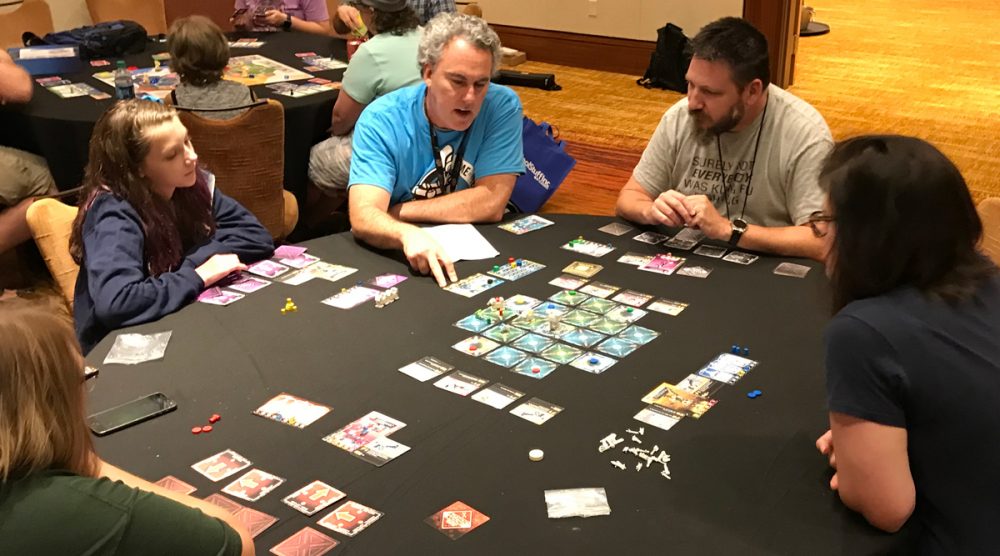
The highlight of the components in Tiny Epic Mechs is, of course, those awesome ITEMeeples, which were first created for Tiny Epic Quest and have now been appearing in many of the Tiny Epic series since then. In TEQ, you controlled three meeples of the same color, so you needed a way to keep track of which meeple had which equipment, and the ITEMeeples were a great way to do that, and have your meeples holding little tiny weapons and items. In the other games (including Tiny Epic Mechs), they aren’t strictly necessary because you only have one meeple, so the cards in front of you indicate what you’re carrying. However, there’s no denying that the snap-on meeple armor and mech are a lot of fun. It does make it easier to tell at a glance what everyone is carrying, though until you’re familiar with the game you’ll still need to refer to the card to know what all the equipment does.

There are a lot of cards involved: the pilot and player cards are all oversized cards, with lots of information and little tokens used to track things like health, credits, and power. The weapon cards and program cards are square. Weapon cards all have illustrations that look like they’d fit in a videogame, and the gameplay and theme certainly do draw from first-person shooters, particularly the sort that involve arena matches where players respawn when they’re eliminated.

The pilot cards are fun—there’s a mix of different characters and abilities. One side shows the pilot, and the other shows the same character decked out in their power armor. Although the actual meeple power armors are all identical, the illustrations let you imagine your character in their unique armor. There are sometimes weapons pictured on both the pilot and armor sides, though the actual weapons you’ll equip will depend on which cards you have.
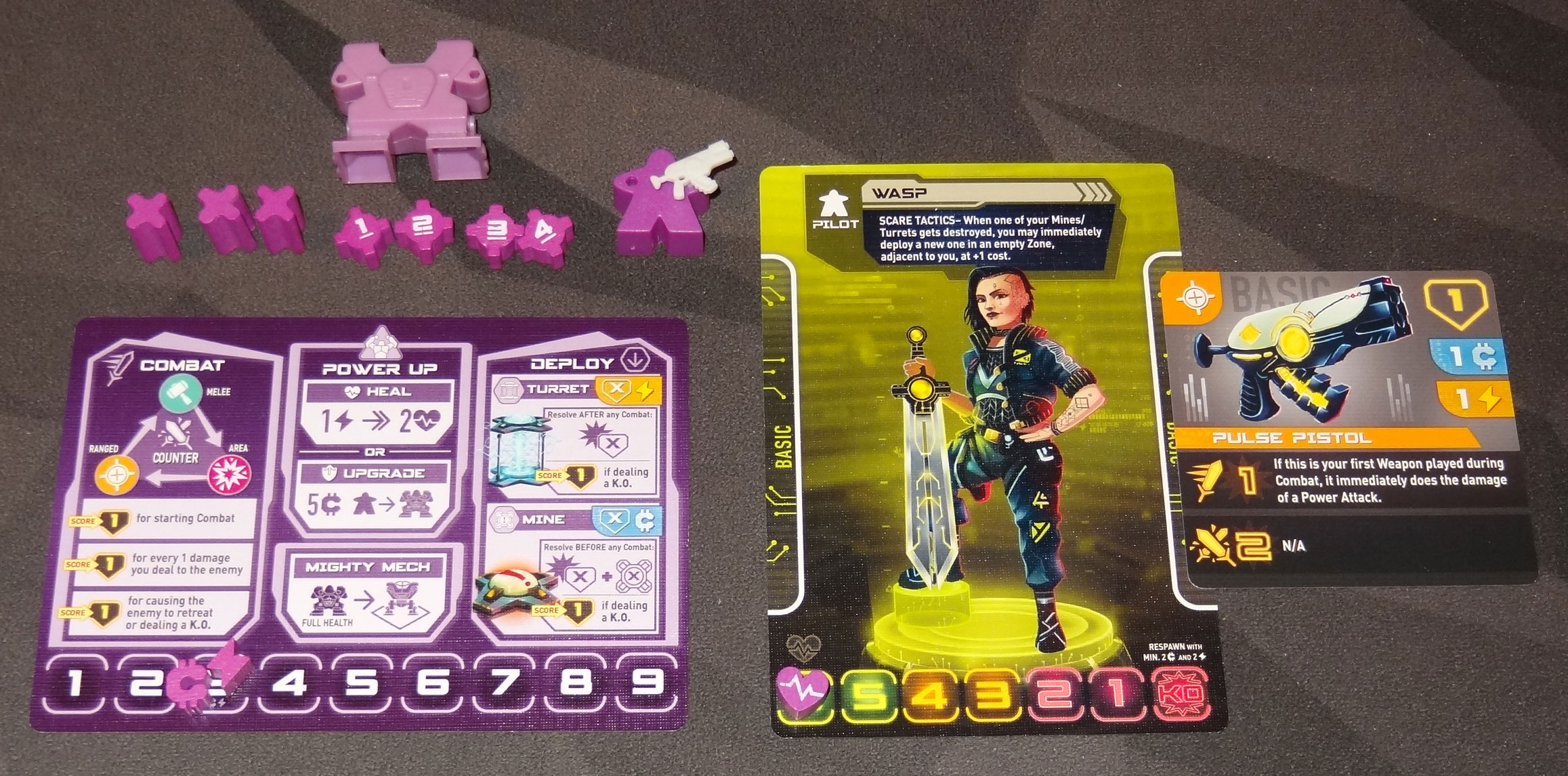
The final version has red, blue, purple, and black/grey for the player colors, which should be better for color blind players than the often-used red, green, blue, and yellow. As you can see, the stretch goals unlocked during the Kickstarter campaign unlocked various shaped wooden tokens for the turrets, mines, and trackers. The score tracker (not pictured here) looks like a little trophy, with a “40+” printed on one side in case you wrap the scoreboard. All of the tokens, as with other titles in the Tiny Epic series, are quite tiny—they’re cute, but you also have to be careful not to bump your cards or you may lose track of how much money, energy, or health you have.

The round tracker card shows the two “hosts” of the mech battle show. The top has the round track with trophy icons on the even-numbered rounds for scoring, and the bottom has reminders about how you score. The round tracker token is now a wooden shield with “M.E.C.H.” printed on it, and the first player token is a small wooden ticket that says “Admit One.”
Aside from the custom wooden components and the player colors, most of the components look pretty much like they did in the prototype, since most of the artwork was already finalized at that point. The power armors are now colored to match the player colors rather than being grey. The cards are a nice quality with a linen finish, and the colors are a little more vibrant than the prototype, but otherwise the prototype did a great job of showing what the final game would be like.
How to Play Tiny Epic Mechs
You can download a copy of the rulebook or even a print-and-play—though of course you’ll have to make your own mech suits and tiny weapons for your meeples, I guess.
The Goal
The goal of the game is to score the most points in six rounds by damaging other players, controlling zones, and purchasing weapons.

Setup
The map setup will vary based on the number of players, but each player will have a starting zone of their player color, and the mighty mech will start on its own designated zone in the center. The rest of the zone cards are randomized.

Give each player a set of player components: a meeple, 4 mines, 4 turrets, the programming cards, player card, and trackers for health, credits, and power. Also, each player will choose a pilot card. You start with 3 credits and 3 power (marked on your player card), and full health (marked on your pilot card). Your meeple starts on your starting zone, and you also place a mine of your choice on your starting zone, with the number side down. (Mines have values from 1 to 4, which indicates how much additional damage they’ll do.)
In addition, give each player a set of the four basic weapon cards. Each player will secretly choose one of the weapons as their starting weapon, and then return the rest to the market. (Then, of course, you find the little plastic weapon and put it into your meeple’s hand.) Your weapon card is placed on your pilot card in one of the two available slots.

The weapons market includes the unused basic weapons, as well as four advanced weapons, randomly dealt from the deck. As weapons are purchased, the row is refilled from the deck.
Place the scoring track and round track next to the map, with the scoring markers near it and the round marker on “1.” Give the start player token to a player. You’re ready to play!
Gameplay
Each round, players will choose four of their program cards to play in a sequence, and then those programs will be resolved in turn order. At the end of every other round, there is also an additional scoring phase.

You have eight programming cards, as well as an Ad Hoc Mode card (which I’ll get to later). Each round, you will place four programming cards that will resolve from left to right. Cover these cards with your remaining four programming cards so that other players can’t see your program. (Note: you could play your cards face-down, but it’s easy to make a mistake when flipping it over to reveal it, so I recommend playing them face-up and covering them as stated in the rules.)

After everyone has finished programming, the cards will be resolved, beginning with the first player’s first card. Each player will resolve one card on their turn, going clockwise until all of the cards have been resolved. You move first, then resolve battles if needed, then take damage from mines or turrets, and then (finally, if you survive all that) take the action.
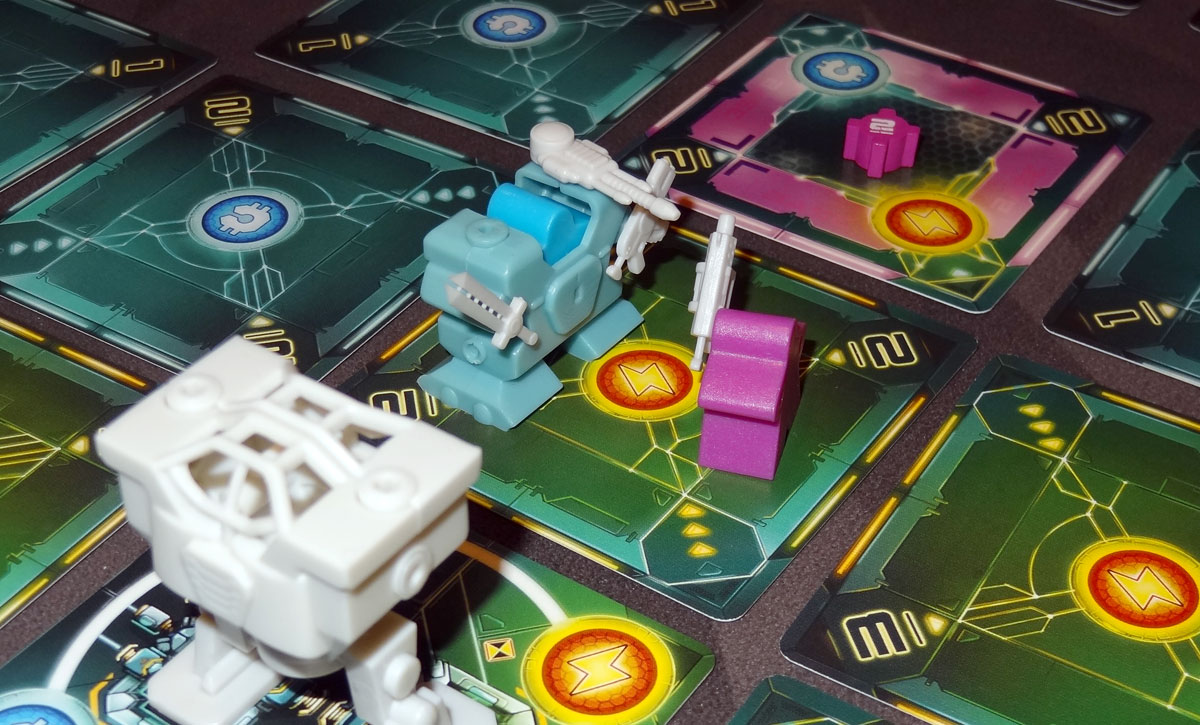
If you step into a space with another player, then you initiate a battle instead of performing the programmed action. The attacker gets 1 point just for starting a fight. Then, starting with the attacker, each player must activate a weapon or retreat.
Each weapon may typically be activated only once during each battle, and you use the top attack effect. If, however, you respond to a weapon with a weapon type that counters it (according to the diagram on your player card), then you get to use its counter ability instead, which is more powerful. Melee weapons counter area weapons; area weapons counter ranged weapons; ranged weapons counter melee weapons. So if the attacker used a sword (melee), and then the defender used a pulse pistol (ranged), the defender could use the pistol’s counter ability instead of the regular attack ability.

You get 1 point for each damage you do to the opponent. If you have no weapons, you must retreat into an available adjacent space without another player in it, and the opponent gets a point for forcing you to retreat. (You are not allowed to retreat voluntarily.) If you reduce a player to 0 health, you get an extra point and that player downgrades if possible (from mech to power suit to pilot) and respawns in their home zone. If you’re reduced to 0 health or forced to retreat, you also place your Ad Hoc Mode card on top of your next programmed card. This lets you move in any direction and take any of the standard actions instead of whatever was programmed there.
Your opponents’ mines and turrets, of course, will damage you. (Your own weapons don’t damage you.) Mines trigger before combat begins and will do damage equal to the value of the space plus the value of the mine, and are removed whether you’re reduced to 0 health or not. In both cases, the owner of the mine will score 1 point for each damage they do. Turrets trigger after combat is resolved, and will do damage equal to the value of the space and score 1 point (total, regardless of damage) for the turret’s owner. If you’re still alive after a turret shoots you, then you remove the turret and give it back to its owner.
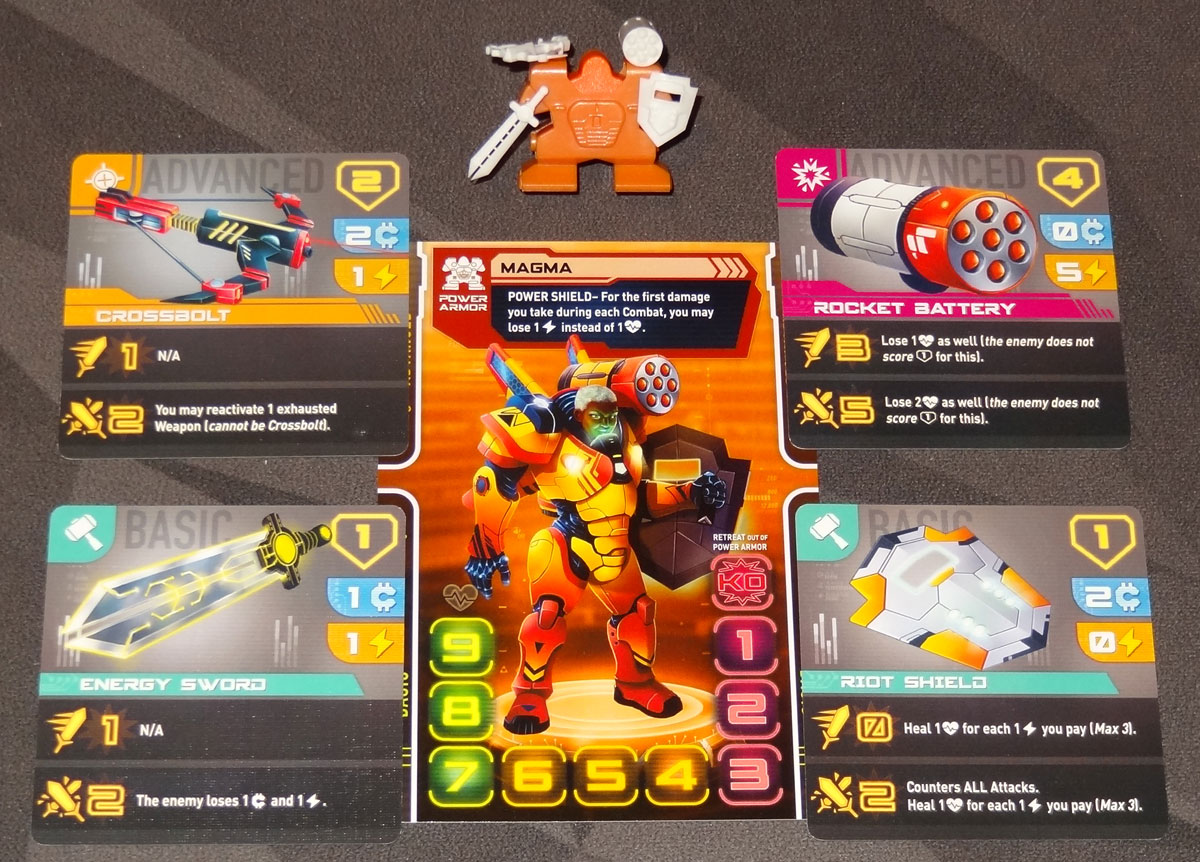
Then, finally, if you’re still standing and you weren’t involved in combat, you take your programmed action. Here are the available actions:
- Deploy Mine: Place a mine on your current space (face-down). Pay credits equal to the space you’re on.
- Deploy Turret: Place a turret on your current space. Pay power equal to the space you’re on.
- Purchase: Spend credits/poert to purchase a weapon in the market. (Refill advanced weapons as needed.) You may now rearrange your weapons as desired.
- Power Up: Heal or upgrade. To heal, pay 1 power for every 2 health you’d like to gain. To upgrade, spend 5 credits to put on your power suit, which also heals you fully. (Note that the mighty mech cannot heal.)
- Collect: Collect 1 matching resource (credit or power) for each zone you control with a meeple, mine, or turret.
- Jump: The double jump skips over a space in an orthogonal direction; the diagonal jump is just one space diagonally. There’s no associated action, but if you start a battle, you get to use the counter ability for your first weapon.
A few clarifications: you may only have 1 mine or 1 turret per zone. When collecting, you get 1 resource per zone (or 2 on the double-resource zones), regardless of the zone’s value. (You don’t get 3 power from a single 3-power zone.)

The mighty mech (also known as Troy 3000) starts in the center of the arena. To get into the mech, you have to enter its space while you’re in your power armor and have full health. If you do so, you automatically switch into the mech at its full health. You’ll score 2 points just for getting the mech. You take the mech card, which covers up your character card and replaces its special ability with its own: you can choose between the two sides of the card, which have different abilities but are otherwise identical. The mech can hold four advanced weapons, but no basic weapons, so if you haven’t purchased any advanced weapons yet then you won’t be able to attack—and that’s bad news, because the mech cannot heal. From then on, if anyone defeats the mighty mech, they switch into the mech and the former driver drops back into their power armor.

Round End
After everyone has had four turns, all of the program cards have been resolved and the round ends. On the even rounds, there’s a scoring phase. Players will score points for zones they control with their meeple, mines, and turrets—meeples and mines score the zone value, and turrets score double the zone value. (If you’re standing in a zone with your mine or turret, you just score that zone once.) You also score 3 points if you currently control the mighty mech. The start player token is passed clockwise, and players set up their programs for the next round.
Game End
The game ends at the end of 6 rounds. In the final round, you also score points for all of the weapons you own, whether they are equipped or not. Each weapon has a point value in the top right corner.
The highest score wins, with ties going to the player with the most leftover resources.

Solo Mode
Don’t have any other players? You can play solo mode! You’ll play on the 3-player map against two robot players, who each start with two basic weapons and power armor. They don’t use pilot cards, and instead of programmed movement, they will use a randomly drawn program card each turn. Instead of using the arrow on the card for direction of movement, they will move based on which action is drawn: for instance, when deploying mines or turrets, they’ll move toward the highest-valued space, in order to maximize the point value and damage.

You program your own four cards as usual, and turn order always starts with you. Once you resolve your card, you resolve the others as well. There are rules for deciding which weapons they will purchase and equip, and the two robots will not hurt each other. (Their mines and turrets will also ignore each other, so there’s no friendly fire.)

Otherwise, scoring occurs as usual—you and the robots all score points for starting battles, doing damage, controlling zones at the end of scoring rounds, and so on. Your goal is to score higher than both robots.

Loot Box Mini Expansion
The Deluxe edition includes two mini expansions. The first is Loot Box, which consists of four loot box tiles. These are randomly shuffled and placed into the four zones adjacent to the Mighty Mech zone at the start of each scoring round (2, 4, and 6). The first player to enter that zone reveals the loot box tile, gains the reward, and then discards it. The rewards include switching into Ad Hoc mode for the rest of the turn (except that you may attack on your next turn), gaining a weapon from the market for free, gaining full health (even if you’re in the Mighty Mech), and powering up for free (from pilot to power armor, unless you’re already powered up).

Spotlight Mini Expansion
The Spotlight mini expansion includes 4 tiny camera drones, represented by screen-printed wooden tokens. During non-scoring rounds, you can gain a camera if you win a combat: it is placed next to your pilot card. (You may only have 1 camera per player.) When you have a camera, you gain 1 extra resource when you use the collect action, and you also score 3 points (and discard the camera) if you have it when scoring occurs. However, if you retreat or lose combat, trigger a mine, or are KO’d by a turret, you lose the camera, and the person who caused you to lose it scores 1 point.

Why You Should Play Tiny Epic Mechs
If you follow me on Twitter, you probably saw a lot of photos of Tiny Epic Mechs last summer during the Kickstarter campaign (as soon as the embargo lifted). I’ve been writing up the Tiny Epic series ever since the first one, and I’m always excited to see what Scott Almes and Gamelyn Games cook up next. When this prototype arrived in the mail, it was the hardest thing not to tell everyone about it right away. Those mini power suits and the mech turned out great. I took it with me to a family vacation, and was able to play it with my siblings, a cousin, and some of my nieces and nephews. And then I took it to Gen Con, where I got to introduce the GeekDads to it, and we also ran a game of it at our Gaming with GeekDad event (and may play it again this year, too).
Aside from the toy factor—which, really, I think it’s worth $20 even if you just gave it to your kids as toys—Tiny Epic Mechs is also a blast to play if you like programming games. I’ve always enjoyed the controlled chaos of this genre, though many of them often take a really long time and may overstay their welcome. Tiny Epic Mechs can be a little longer the first time you play as everyone’s learning the rules, but once you’re familiar with it the 30–60-minute range is about right. You may even wish you had more than just 6 rounds.
The thing about programming games, of course, is that what you plan and what you end up doing may be quite different. At the very beginning, things are pretty easy because everyone’s far apart. You know you can move around a bit and you won’t run into anyone, so things will run as programmed. But the map’s not that big, and pretty soon you’re moving to the right so you can collect resources and oh there’s somebody there already, and that’s when the battles begin. Early battles aren’t so exciting, because if you’ve each only got one weapon, at most you can trade blows and then the attacker is forced to retreat because they have no more weapons. Once you start accumulating some firepower, though, things get more interesting, as each player has to evaluate whether they’re going to survive a battle before attempting to jump into somebody’s space.
Whether the battle ends in defeat or retreat, though, one thing is certain: the program’s been disrupted, and may have cascading effects. I’ve seen games in which players battled, and then one player retreated only to find that the other player was going to move into that space on their next turn. Ideally, if you can predict where somebody’s going to be (or your turn is before theirs), you can take advantage of the jump move to leap into battle, and use the counter ability of your weapon. The downside is that if you guess wrong, you’ve just moved without getting to take any other sort of action, which seems like a bit of a waste.

There are various tactics you can take during the game—grab a few more credits and get into your power armor quickly, so you can go after the mighty mech (but don’t forget to purchase a few advanced weapons soon!). Or maybe you want to run around and set up mines and turrets, limiting other players’ movement and making your resource collection more profitable. The starting zones are pretty valuable because they’re worth 2 points and they provide both resources when you collect, so it can even be worth running over to somebody’s home, triggering their mine, and then setting up your own mine or turret there (assuming you survive the blast).
I didn’t really get into the player powers, but each character has a special ability, and there’s a variety of ability types. Magma can spend energy instead of health for the first point of damage in battle. Maverick can spend credits to use an ability again. Tank takes less damage from mines and turrets. Each pilot has a particular strength—can you figure out how to use it most effectively? The multitude of weapons available also gives you lots of different options.
Tiny Epic Mechs is GeekDad Approved!
I don’t usually play a lot of solo games, but I gave the solo mode a try just to get a feel for how it works. The 3-player map is usually not my favorite because, with a square-based map, it means that the three players aren’t all spaced out the same: the player in the center is closer to the Mighty Mech and farther from the other players, which may be a slight advantage. For solo mode, however, that gets balanced out a little because the robots start with power armor and an extra weapon.
The game had a bit of the same feel: figuring out where I wanted to go, getting disrupted by a robot who marched into my space, cringing because I knew I was going to run out of weapons in a battle. But because the robots are a bit mindless, it also meant that they sometimes took suboptimal moves, like using “collect” even when they had already maxed out their resources instead of attempting to place turrets and mines. The one advantage they do have is that their “jump” actions can allow them to move any distance if they can reach you, but if you manage to escape combat, they’re not as good at pursuing you. There’s also not any sort of difficulty setting on the robots, so you can’t make them harder or easier. I generally prefer playing against human players, and I think that will still be the case for Tiny Epic Mechs.
Whether you love tiny mechs or programming games, or you’re just a fan of the Tiny Epic series, Tiny Epic Mechs is definitely worth a closer look. I think Gamelyn Games and Scott Almes have another hit on their hands, and I’ll be surprised if this one doesn’t hit all its stretch goals in short order. For more information or to make a pledge, visit the Tiny Epic Mechs Kickstarter page!
Click here to see all our tabletop game reviews.
![]() To subscribe to GeekDad’s tabletop gaming coverage, please copy this link and add it to your RSS reader.
To subscribe to GeekDad’s tabletop gaming coverage, please copy this link and add it to your RSS reader.
Disclosure: GeekDad received a copy of this game for review purposes.





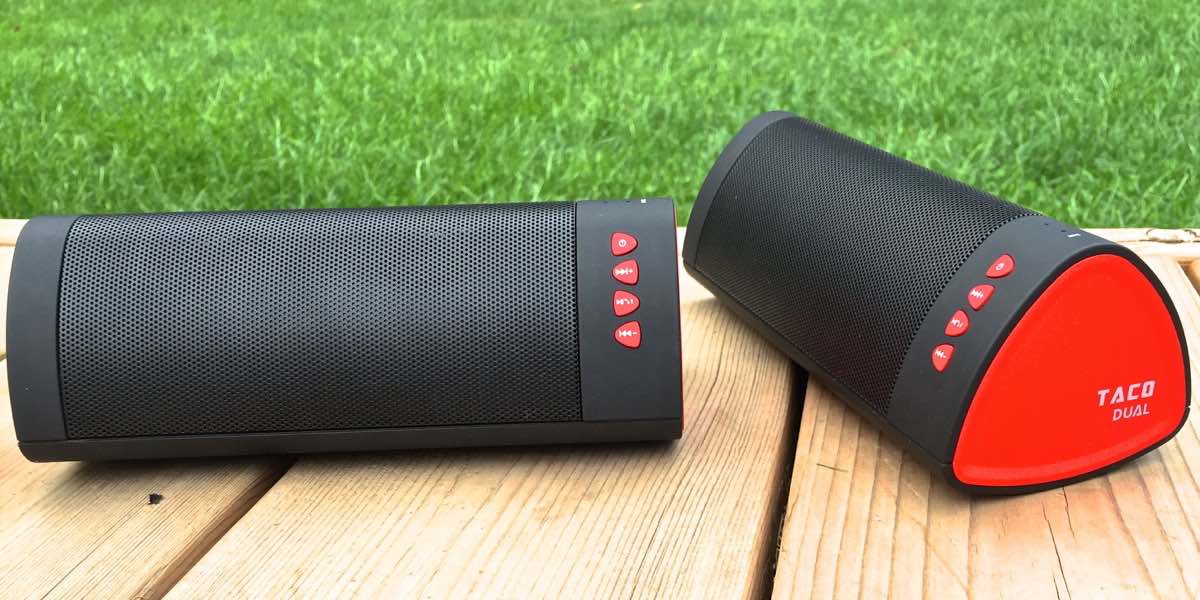

Excellent write-up. I agree that the toy factor is high for this. My youngest enjoyed equipping the pieces and swapping things around. She had a little trouble with the mighty mech – opening/closing/putting a meeple inside, but it wasn’t that bad. The meeples jumped around for a while, had parties, mock battles, long conversations, and entertained her for a bit.
I haven’t tried to play the game with her yet. It might still be a _little_ too advanced, but good to read that you’ve had some success there with the younger set. (I’m sure they’re versed in games already, but still – good to know.)
I did have some trouble with the Mighty Mech in the prototype, but the finished version seemed to work okay for me—though of course there can be some variation in manufacturing, I suppose. My youngest (6) was also fond of playing with the mechs and meeples. Last summer during the Kickstarter campaign I played with my nieces and nephews—the youngest were 6 at the time—and they were able to play with a bit of assistance from parents.
I bet it would be possible to create some simplified rules that just get kids used to programming moves and orienting the arrows—you could set up some mines and turrets as obstacles, and let them program their way to the Mighty Mech, or something like that, short of playing the full game, which can get a little complicated!
Good point. We’ve already played Robot Turtles a couple of times so the “programmed movement” isn’t that foreign. This adds another layer of interaction. Definitely a little different than turtles, but the toy factor is high.
Ah, yes! If your kids have already played Robot Turtles, then this can add on top of that. I know the basic Rules for that never had them interacting with each other on the board (though some of the advanced variants did). This gets them to deal with what happens when your planned movement runs into somebody else’s planned movements. I suppose an extra-simplified version would be to just bump somebody back or something like that, if you weren’t ready to deal with combat yet. But once you do get to the combat, then a lot of other interesting considerations come into play.